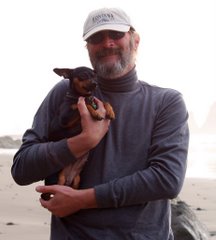
Sign posted at staging area
North Fork Smith River
I hope they didn't mean me!
Taken 1/5/07
When passion kicks in, every thing else tends to fly out the window. If you are fortunate enough to have found passion in your life, nurture it. Nothing else truly matters. For me, photography has become my passion. When I’m out in search of the perfect shot, I lose track of time, hunger, thirst. And since I usually have Gypsy with me, let’s hope she loses any interest in food or water too. Unfortunately for her, I tend to forget that she has food and water in the car, just not where she can get to it.
Thank God for digital cameras. Today I shot 232 pictures with the Nikon D80 Digital Single Lens Reflex and 6 with my Nikon Coolpix L3. That’s roughly the equivalent of ten 24-exposure rolls of film, or $120 in developing and printing costs had I been using 35 mm film. But cost isn’t, or at least shouldn’t be the issue. The matter at hand, always, is quality. Have I found anything at all worth sharing? Do any of these pictures tell the story I want told?
Recently I read an article in the December 2006 issue of Shutterbug magazine where photographer Jack Hollingsworth states that since he went digital he shoots two to three thousand photographs a day. I immediately felt like a piker. I’ve been shooting roughly 200 a day since I got the L3 back in October. I worry that I’ll run out of space on my hard drive as I diligently transfer the pixels from camera to computer. Of course other than a paycheck, and a very handsome one at that, what sets Jack Hollingsworth apart from happy snappers like me is that he has paid assistants who go through those thousands of images daily, discarding the ones that just don’t make it.
Having an assistant is only one answer, though, to the problem of too many images. When I ran my idea of becoming a travel writer/photographer past my friend and former co-worker Dennis Kern, Dennis, a photography professor at Montana State University—Billings, suggested that the ease of snapping digital images can be a trap. Instead of taking the time to find exactly the right shot, we just shoot away happy in the knowledge that we won’t have to develop and print in order to see what we’ve shot. Actually, most digital cameras these days are so sophisticated that you don’t even need a computer. You can do just about any editing you would want in the camera itself. This is not, however, what I do. Whether it’s my eyes needing further adjustments, or the small size of the camera viewer, or just an innate disinclination to really master all the wonderful capabilities of the D80, I prefer to transfer the pics to my computer and then use the oversized screen and Photoshop Elements to do my editing. Between the two peer review sites to which I submit photos, and this blog site, I need to find 8-9 images daily that please my eye and tell the right story. I find it challenging to narrow 238 photos down to nine.
This morning dawned bright and clear—perfect for catching those morning shots I’ve been meaning to get. Rushing through my morning business, I grabbed the camera gear and my faithful photographer’s assistant, Gypsy, and jumped in the Volvo ready to go where the muse led. I did have a few shots in mind. There’s a great image just waiting for me at the Crescent City Harbor. I’ve already taken the photograph several times—but always with the light in the wrong position. I need to be there in the early morning, and this morning would have been perfect. There’s an image I’m dying to attempt where you catch both of Crescent City’s lighthouses in one shot—but you have to be in a certain location and have a much longer lens than I have in order for that to work. Then there’s the view of Smith River, the fields beyond the town, the river itself, and finally the Pacific.
On a recent photo shoot I headed up Rowdy Creek thinking to turn onto the Low Divide and get some pictures of the coast line from 1500 feet elevation. The snow, however, was too heavy and the road too narrow, so I turned around. Heading back down Rowdy Creek I saw the perfect shot, and actually attempted it. Alas the weather conditions meant that there was a lot of haze and no sun to speak of. Perhaps this morning I could grab that shot then head to the harbor. I was ready to drive to the ends of the earth for sun-lit scenes. Well, if not the end, at least further up the Oregon Coast, or south of Eureka California. But then I realized that spending the daylight hours driving just didn’t make sense if I was really intent on capitalizing on the sunshine. So, back up Rowdy Creek to see what I could find.

Smith River, the Coastal Plain, and the Pacific
Taken 1/5/07 on Rowdy Creek Road, Smith River California
In this shot of the coastal plain as seen from up Rowdy Creek Road, you can see the Pacific in the distance, then the sand spit that separates the ocean from the river. Next comes the river, flowing parallel to the ocean. Inland from that the lily fields that produce 80% of the Easter Lilies sold in the US. Finally, near the foreground, you can see the town of Smith River itself. In fact, in this shot you can actually see the steeple of my father’s last church, and if you know where to look and really enlarge the shot, you can almost see my house. This is the shot I had counted on getting—but again, while we had sunshine and therefore blue water, there was still much too much haze in the air for a truly great landscape shot. I hope you can enjoy it anyway.
Now understand, I haven’t been very far up this road in over thirty years. As I recalled, we drove for quite some time through forests, bare land that had been logged, and past gravel pits, eventually ending up down on US 199 near Patricks Creek. Recently there have been two letters in the Crescent City newspaper suggesting that rather than try to improve 199, a new highway should be built following the old roads I was driving on. These letters suggested that if you went far enough, you’d end up near Cave Junction, Oregon. Ok, I said. Let’s just see where the road leads us and what we find along the way. The Volvo is all-wheel drive, and I’ve never been afraid of mountain logging roads, so what the hey.
On and on we drove, stopping every few miles to get out, set up the tripod, take some shots—ok more than some shots—and let Gypsy run for a bit. The road climbed quite steeply in places, dipped down a ways, then resuming its uphill trajectory. With the sun shining brightly overhead, we drove on dry gravel, bare rock, wet sand, snow. We took pictures of rocks, trees, distant mountains, rushing streams, Darlingtonia (which seems to be on the verge of becoming my signature plant). And then the road started dropping—precipitously. Around another curve or two and a bright blue ribbon of water appeared in the distance. This must be the North Fork of the Smith River. And then we were down at the river’s level. Well, this must mean we’re close to civilization. There’s a white water boat staging area and a National Forest campground here—not to mention a very nice, relatively new bridge. And a very large house behind a fence, a locked gate, and enough Keep Out signs to stock a small store. Surely, if I just cross the river, and head on a ways, I’ll be out of the wilderness and on a paved highway, US 199.

North Fork Smith River
24 miles at 20 mph (max) from US 101
Taken 1/5/07
At mile 28 I had the choice of taking the right fork or the left. Neither looked promising. I had now lost the sun. The road was muddy to the point of being dangerous, and it looked as if storms were approaching. US 199 was nowhere in sight. I turned the car around, parked, and Gypsy and I set out to determine where the right fork might lead. We may have hiked a mile up the road, maybe half that. But all we saw was more of the same, road without end, as it were, twisting and turning, climbing and dipping, but going, as Tolkien put it, ever on.
Leaving further exploration for another day, Gypsy and I headed back to the car where I stowed my gear, put Gypsy in her travel crate, and began the long trek home. Vowing that I wouldn’t stop for any more photo ops, I almost made it. The turnaround photo was number 200 of the 232 on the D80. It was a long day, a richly rewarding day, a day I’d gladly repeat over and over again. In short, it was a day of passion. (More on this subject tomorrow.)

28 miles at 20 mph (max) from US 101
No sun, storm coming, turn the car around! NOW!
Taken 1/5/07
 Smith River, the Coastal Plain, and the Pacific
Smith River, the Coastal Plain, and the Pacific






No comments:
Post a Comment